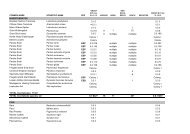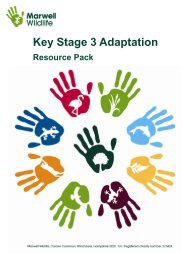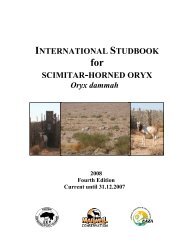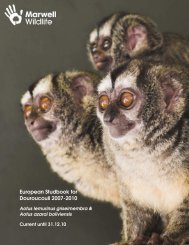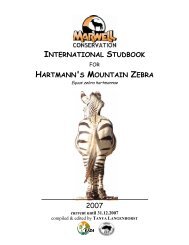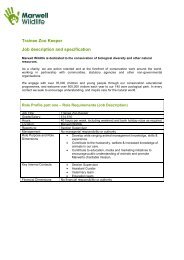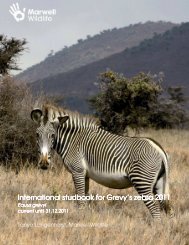international studbook hartmann's mountain zebra - Marwell Zoo
international studbook hartmann's mountain zebra - Marwell Zoo
international studbook hartmann's mountain zebra - Marwell Zoo
Create successful ePaper yourself
Turn your PDF publications into a flip-book with our unique Google optimized e-Paper software.
Hartmann’s <strong>mountain</strong> <strong>zebra</strong> Conservation & Research<br />
Once more I would like to introduce a research project on Hartmann’s <strong>mountain</strong> <strong>zebra</strong> in the wild. This is a<br />
summarised proposal. For more details or the project budget, please contact the authors. Should you know of<br />
any projects going on in the field or in zoos, please let me know, so I can include this information here.<br />
Identifying key conservation management areas for Hartmann’s <strong>mountain</strong> <strong>zebra</strong>s<br />
(Equus <strong>zebra</strong> hartmannae)<br />
Pilot Project<br />
Dr. Tara Harris and Mr. Jeff Muntifering<br />
Minnesota <strong>Zoo</strong><br />
Apple Valley, Minnesota, USA<br />
January 2009<br />
Contacts: tara.harris@state.mn.us OR jrmunti@yahoo.com<br />
Rationale: Mountain <strong>zebra</strong>s (Equus <strong>zebra</strong>) are a unique and lesser known <strong>zebra</strong> species, inhabiting dry and<br />
<strong>mountain</strong>ous regions of Namibia and South Africa. They are listed as “vulnerable” by the IUCN (Redlist<br />
2008) because their populations are thought to number ~9,000 mature individuals and Hartmann’s <strong>mountain</strong><br />
<strong>zebra</strong> (Equus <strong>zebra</strong> hartmannae) populations are thought to be declining overall. Whereas numerous<br />
scientific publications have focused on the Cape <strong>mountain</strong> <strong>zebra</strong> (Equus <strong>zebra</strong> <strong>zebra</strong>) in South Africa, very<br />
little is known about Hartmann’s <strong>mountain</strong> <strong>zebra</strong>, which are almost exclusively located in Namibia.<br />
Currently, <strong>mountain</strong> <strong>zebra</strong>s are found in scattered populations throughout Namibia, with the majority<br />
occurring in national parks, in conservancies managed by local communities, and on private lands. Yet, little<br />
is known about their seasonal space use, population performance, or whether they are able to move among<br />
fragmented populations.<br />
Thousands of Hartmann’s <strong>mountain</strong> <strong>zebra</strong>s persist in the Kunene Region of northwestern Namibia under<br />
extremely harsh environmental conditions. In this area, they are hunted for trophies, commerce, and<br />
subsistence, and are also a subject of tourist activities. To construct effective long-term conservation<br />
measures for <strong>mountain</strong> <strong>zebra</strong>s in the Kunene Region, it is first important to understand their basic behavioral<br />
and ecological traits, including movement patterns and habitat use.<br />
Long-term objective: Our overall aim is to identify key conservation areas for Hartmann’s <strong>mountain</strong> <strong>zebra</strong>s<br />
and to work with the Namibian government, local people and conservation NGOs to craft a regional<br />
conservation action plan for this subspecies to inform land use and management practices. We will attempt<br />
to identify areas within and around the protected areas that are critical for <strong>mountain</strong> <strong>zebra</strong> conservation and<br />
management. In particular, we seek to identify key seasonal movement and habitat use patterns across the<br />
study area and determine whether gene flow is occurring across seemingly fragmented <strong>mountain</strong> <strong>zebra</strong><br />
populations.<br />
Pilot project objective: Because so little is currently documented about Hartmann’s <strong>mountain</strong> <strong>zebra</strong>s, it is<br />
first necessary to conduct a pilot project to gather information for the larger project. First, we will identify<br />
and engage collaborators in Namibia and South Africa for assistance in achieving the larger project<br />
objectives. We will also bring together all available spatial data (environmental and human use) in the region<br />
(for habitat assessments) and survey local people and researchers that have lived/worked in the study region<br />
to find out what local knowledge exists about <strong>mountain</strong> <strong>zebra</strong> seasonal movements and breeding, as well as<br />
current land use practices that may influence <strong>mountain</strong> <strong>zebra</strong> movements and population persistence. We will<br />
collect a limited number of fecal samples from wild <strong>mountain</strong> <strong>zebra</strong>s and establish the genetic sampling and<br />
analysis methods. Lastly, we will attempt to locate and collect preliminary data on <strong>mountain</strong> <strong>zebra</strong> groups<br />
and will search for congregations of animals during critical periods, if possible.<br />
AII





